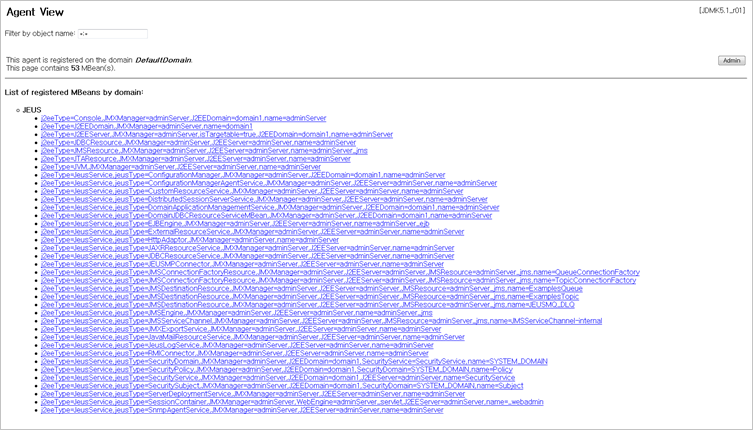Searching for MBean Information and Configuring the JMX Manager
This chapter describes how to search for information about JEUS MBeans and configure a JMX Manager environment.
1. Searching for MBean Information
MBean information can be searched for using a console tool (jeusadmin).
1.1. Using the Console Tool
MBean information can be retrieved by using a console tool named 'jeusadmin'.
Log on to the JEUS server using the jeusadmin tool and then run the mbean-info command. The information for the registered MBeans is displayed as follows:
[MASTER]domain1.adminServer>mbean-info -server adminServer
The object names of MBeans on the server [adminServer].
================================================================================
+------------------------------------------------------------------------------+
| JEUS:j2eeType=JeusService,jeusType=ThreadPool,JMXManager=adminServer,J2EEServ|
|er=adminServer,name=threadpool.System |
| JEUS:j2eeType=JeusService,jeusType=JMSDestinationResource,JMXManager=adminSer|
|ver,J2EEServer=adminServer,JMSResource=adminServer_jms,name=ExamplesQueue |
| JEUS:j2eeType=JeusService,jeusType=JEUSMPConnector,JMXManager=adminServer,J2E|
|EServer=adminServer,name=adminServer |
. . .
| JEUS:j2eeType=JeusService,jeusType=JNDIResourceService,JMXManager=adminServer|
|,J2EEServer=adminServer,name=adminServer |
| JEUS:j2eeType=JTAResource,JMXManager=adminServer,J2EEServer=adminServer,name=|
|adminServer |
| JEUS:j2eeType=JMSResource,JMXManager=adminServer,J2EEServer=adminServer,name=|
|adminServer_jms |
+------------------------------------------------------------------------------+
================================================================================
2. Configuring the JMX Manager
JEUS JMX provides JEUS components and real-time information to client applications in accordance with JMX Remote API specification 1.0. This section describes how to configure JMX Manager environment.
JMX Manager related settings are found under the server settings in the configuration file (domain.xml). To configure them, you must directly edit the XML file.
The configuration items are as follows.
-
Basic Configuration
<server> ... <jmx-manager> <use-rmi-connector>true</use-rmi-connector> <use-html-adaptor>true</use-html-adaptor> <html-adaptor-port>8098</html-adaptor-port> <snmp-adaptor> ... </snmp-adaptor> <mlet-url>file:///home/user/mlet/example.mlet</mlet-url> </jmx-manager> ... </server>Option to use an RMI Connector, HTML Adapter, HTML Adapter Port, and MLet URL information.
Item Description Use Html Adaptor Port
HTML Adaptor is JMX’s protocol adapter that supports HTML.
For more information about the HTML Adaptor, refer to Getting Started with JMX.
Use Rmi Connector
Option to use an RMI Connector. If enabled, the RMI Connector server instance is created when the server is started.The URL for connecting to the RMI Connector server is in the format "service:jmx:rmi://SERVER_ADDRESS:SERVER_BASE_PORT/jndi/SERVER_NAME".
Html Adaptor Port
The HTML adapter port is used to access the adapter through a web browser. If set to -1, the JMX Manager does not use the HTML protocol. Make sure not to use a port that is used by other services.
To verify that the HTML adapter has been configured successfully, run the web browser and then access the server using the IP address of the server and the specified port number.(Refer to HTML Adaptor Access Page).
MLet URL
Sets the MLet URL to register with the MBean server. For the specified MLet URL to be applied, the server needs to be restarted. For more information about MLet, refer to MLet API Documentation.
-
Snmp Adaptor
SNMP adapter is an SNMP protocol adapter provided by JMX. It can be set as a child item of the JMX manager setting.
<server> ... <jmx-manager> ... <snmp-adaptor> <snmp-adaptor-port>8099</snmp-adaptor-port> <snmp-version>3</snmp-version> <snmp-max-packet-size>256</snmp-max-packet-size> <trap-demon> <ip-address>127.0.0.1</ip-address> <port>9099</port> </trap-demon> <pooling> <min>1</min> <max>5</max> <period>30000</period> </pooling> </snmp-adaptor> ... </jmx-manager> ... </server>Item Description Snmp Adaptor Port
Listener port of the SNMP adapter.
Snmp Version
SNMP version. 1,2 or 3 can be used.
Snmp Max Packet Size
Maximum SNMP packet size. The minimum size is 256 bytes.
Snmp Security
Indicates whether to enable SNMP security. This option can only be specified in SNMP 3.
Trap Demon
Server to send trap messages to after an error occurs. Multiple addresses can use used. The address can be specified in the 111.111.111.1:8888 format.
Pooling
Configures properties of the thread pool that handles requests sent to the SNMP server.
-
Min: Minimum number of threads to be used by the tread pool.
-
Max: Maximum number of threads to be used by the tread pool.
-
Period: Sets the period for adjusting the pool size. For detailed information on SNMP and SNMP Adaptor settings, refer to SNMP Agent Configuration in JEUS SNMP Guide.
-
The following is the screen that shows the HTML adapter is running successfully.
